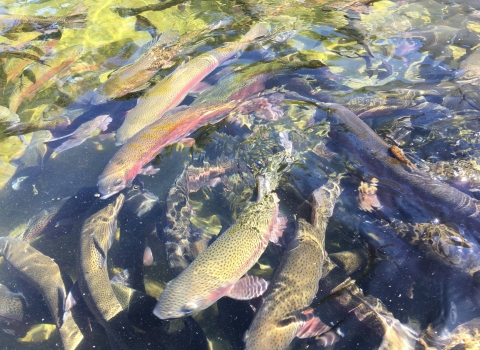While non-motorized travel across refuge and waterfowl production lands is allowed, motorized travel is prohibited to protect wildlife and wildlife habitat.
"Like other national wildlife refuges we dont permit snowmobiles, ATVs, or other motorized vehicles on the refuge, except on designated roads," said Mary Stefanski, who manages the Rice Lake NWR near McGregor, Minn. "Vehicles can damage vegetation and create ruts, but the biggest problem is that they disturb wildlife, which can already be under stress from winter conditions."
Stress isnt a problem on the Rice Lake refuges seven miles of groomed ski trails, which loop throughout the refuge and offer outstanding wildlife viewing opportunities. "Once out on the trails its very quiet and peaceful. The ducks are gone of course, but at Rice Lake youll still see resident birds, deer, the northern owls and maybe even signs of wolves," Stefanski said.
"We also have a lot of old logging roads that are great for snowshoeing," she said, though cautioning that the groomed trails are reserved for skiers alone.
Many national wildlife refuges, especially those in Minnesota, Wisconsin and Michigan, offer similar "wildlife friendly" winter recreation opportunities. Even refuges near major cities, like the Minnesota Valley NWR in Bloomington, Minn., afford visitors the ability to "get away from it all" for at least a short time.
With few exceptions, no special permits or stickers are needed to take advantage of winter sports on national wildlife refuges. Public use hours at most refuges are from sunrise to sunset. Stefanski advises potential refuge visitors to contact the refuge staff or stop by refuge headquarters for information on any restrictions as well as for tips on the best skiing areas and upcoming special events. More information on national wildlife refuges in the Midwest is also available at http://midwest.fws.gov
The U.S. Fish and Wildlife Service is the principal Federal agency responsible for conserving, protecting and enhancing fish, wildlife and plants and their habitats for the continuing benefit of the American people. The Service manages the 93-million-acre National Wildlife Refuge System which encompasses more than 530 national wildlife refuges, thousands of small wetlands and other special management areas. It also operates 66 national fish hatcheries, 64 fishery resource offices and 78 ecological services field stations. The agency enforces Federal wildlife laws, administers the Endangered Species Act, manages migratory bird populations, restores nationally significant fisheries, conserves and restores wildlife habitat such as wetlands, and helps foreign governments with their conservation efforts. It also oversees the Federal Aid program that distributes hundreds of millions of dollars in excise taxes on fishing and hunting equipment to state fish and wildlife agencies.


